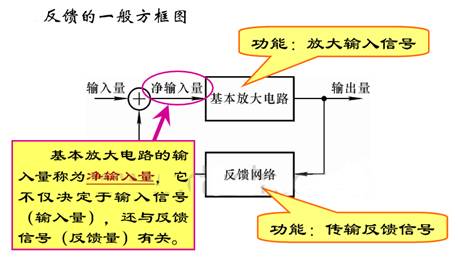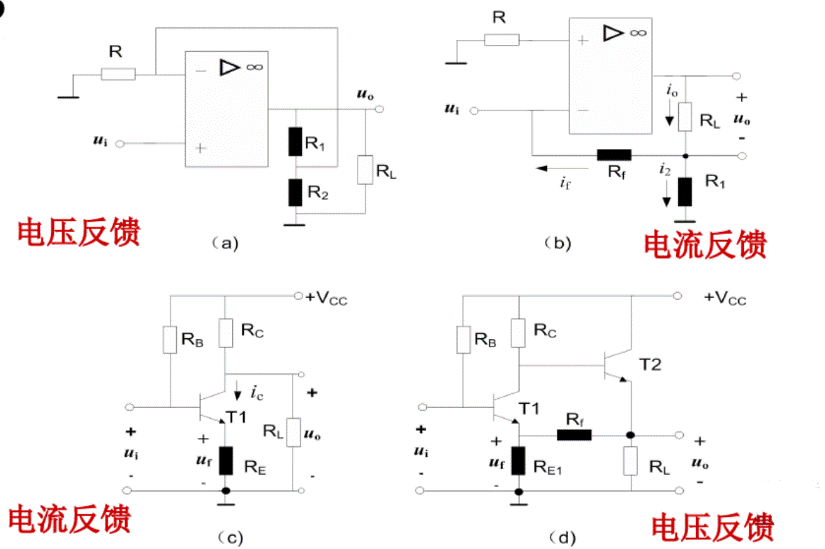如何判断电压、电流反馈
发布日期:2024-02-04
点击次数:328
在电子电路中,将输出量(输出电压或输出电流)的一部分或全部通过一定的电路形式作用到输入回路用来影响其输入量放大电路的输入电压或输入电流)的措施(或过程)——称为反馈。
对“反馈”概念的理解关键要注意两点:
(1)在输出端与输入端之间必须建立起通路;
(2)输出量作用回输入端后,必须对输入量产生一定的影响。
把输出端与输入端相连,|并有输出量对输入信号产生影响的一定电路形式,常被称为反馈通路。


放大电路反馈类型有什么
放大电路的反馈类型通常有以下几种:
1. 电压负反馈(Voltage Negative Feedback):这是最常见和最常用的反馈类型。在电压负反馈中,部分输出信号被馈回到输入端与输入信号相减,以减小输出信号与输入信号之间的差异。这种反馈方式使得放大电路的增益、频率响应和非线性失真都得到了改善,从而提高了系统的稳定性和性能。
2. 电流负反馈(Current Negative Feedback):在电流负反馈中,部分输出电流被馈回到输入端,与输入电流相减。这种反馈方式可以减小放大电路的非线性失真,并提高电压增益的稳定性和线性度。电流负反馈通常用于需要高精度和低失真的放大电路。
3. 正反馈(Positive Feedback):正反馈会使得输出信号与输入信号同相或者相位关系增强。这种反馈方式会导致放大电路增益变得不稳定,甚至引起震荡。因此,在放大电路设计中一般避免使用正反馈,而是采用负反馈来稳定系统。
虽然负反馈在大多数放大电路中被广泛应用,但不同的放大电路可能需要不同类型的反馈来满足特定的需求。
如何判断电压、电流反馈
电压、电流反馈的判断
(1)定义法
根据电压、电流反馈定义直接判断。即反馈信号的大小与输出电压成比例时是电压反馈;与输出电流成比例就是电流反馈。
(2)输出短路法
将输出电压‘短路’,或令负载R=0,如果此时反馈信号不存在了,即X=0,则是电压反馈;若反馈信号仍然存在,则是电流反馈。

放大电路的反馈原理是通过将一部分输出信号重新引入到输入端,与输入信号相结合,以改变放大电路的工作状态和性能。具体原理如下:
反馈网络:在放大电路中引入一个反馈网络,将输出信号的一部分馈回到输入端。这个反馈网络可以由电阻、电容、运算放大器等元件组成。通过反馈网络,引入的反馈信号与输入信号相混合。
误差信号:将混合后的反馈信号与输入信号相减,得到差异信号,即误差信号。误差信号表示了输出信号与期望信号之间的差异。
调整输入信号:根据误差信号,对输入信号进行调整。通过相应调整输入信号的幅度、相位等特性,使得输出信号更接近期望的信号。
调整工作状态:反馈信号的引入会影响放大电路的工作状态,如工作点、偏置电流等。通过调整这些工作状态,可以改变放大电路的增益、线性度等特性。
稳定性:反馈系统可以帮助稳定放大电路的工作。当外部因素引起放大电路工作点变化时,反馈信号可以相应地调整放大电路的输出,以保持系统的稳定性。
总体来说,通过反馈原理,放大电路可以根据误差信号自我调节,并改变其工作状态,以使输出信号更接近期望的信号。负反馈还可以降低增益、提高线性度、扩展频率响应,并调整输入阻抗和输出阻抗。因此,反馈原理是设计和优化放大电路的重要方法。
|
免责声明: 本文章转自其它平台,并不代表本站观点及立场。若有侵权或异议,请联系我们删除。谢谢! |











